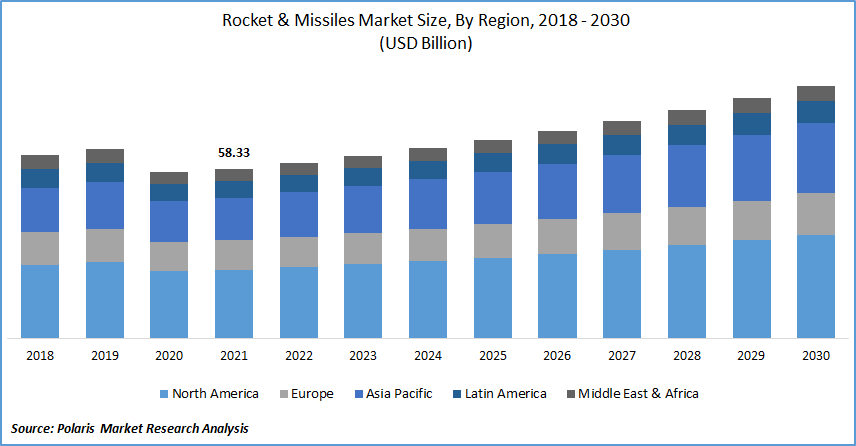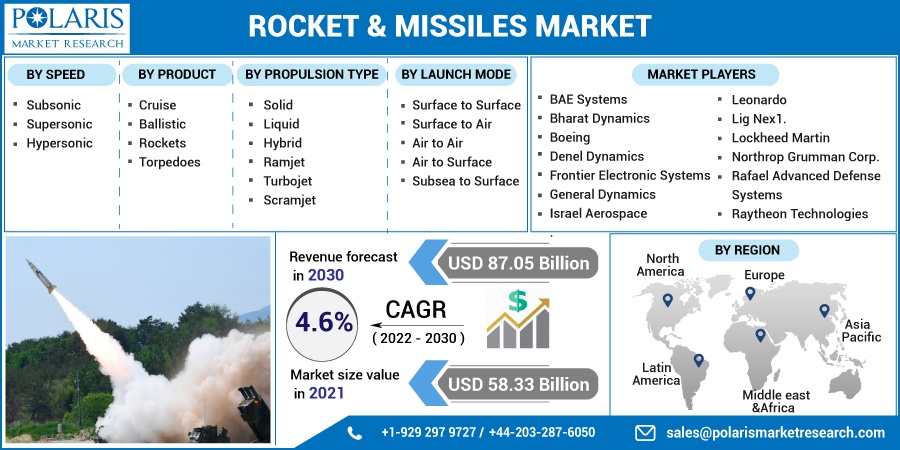
Rockets and Missiles Market Share, Size, Trends, Industry Analysis Report, By Speed (Subsonic, Supersonic, Hypersonic); By Product (Cruise Missiles, Ballistic Missiles, Rockets, Torpedoes); By Propulsion Type; By Launch Mode; By Region; Segment Forecast, 2022 - 2030
- Published Date:May-2022
- Pages: 101
- Format: PDF
- Report ID: PM2374
- Base Year: 2021
- Historical Data: 2018 - 2020
Report Summary
The global rockets and missiles market was valued at USD 58.33 billion in 2021 and is expected to grow at a CAGR of 4.6% during the forecast period. Factors such as the development of new-generation air and missile defense system, increasing incidents of terrorists, and others are driving the rockets and missiles market growth during the forecast period.
 Know more about this report: Request for sample pages
Know more about this report: Request for sample pages
Terrorist activity is rising, as territorial conflicts could lead to a clash with neighboring countries. This has resulted in close combat battle scenarios. The technique built into traditional rockets can be easily tracked due to advanced detection techniques. As a result, nations must constantly improve their technologies, making it impossible to differentiate during the war. These factors increase the global supply of rocket and missile production.
However, market growth is hindered by a few factors, such as the rising cost of advanced technologies. Manufacturers of rockets are constantly working to improve their products by incorporating new technologies. When compared to older technologies, these new technologies are prohibitively expensive. As a result, the cost of the finished product is rising, impeding the growth of the global rockets and missiles market in developing countries.
 Know more about this report: Request for sample pages
Know more about this report: Request for sample pages
Industry Dynamics
Growth Drivers
The achievement of U.S. weapon systems is incomparable, providing the U.S. defense forces with a conducted training advantage over any opponent in any weather condition. The U.S. Department of Defense (DoD) has requested USD 247.3 billion in purchasing funding for the year 2020 acquisition, including the Minimum amount and the Overseas Contingency Operations (OCO) fund, amounting to USD 143.1 billion Procurement and USD 104.3 billion for RDT&E.
The financial support in the budget request represents a balanced portfolio approach to implementing the National Defense Strategy's military force objective. The proposal for USD 247.3 billion includes USD 83.9 billion for Major Defense Acquisition Programs (MDAPs), which are procurement programs that surpass a cost threshold set by the Under Secretary of Defense for Acquisition and Sustainment.
As per the Missile Defense Agency (MDA), more than 1,200 ballistic missiles have been added in the past few years. Outside of the United States, the North Atlantic Treaty Organization, Russia, and China, missile systems have risen to over 5,900. Thousands of launchers and missiles are presently within range of U.S. forces on the ground. Also, between fiscal years 1985 and 2019, Congress authorized more than USD 200 billion for Missile Defense Agency (MDA) programs. As a result, nations' growing need for defense programs to defend against various threats is propelling the rockets and missiles market.
Report Segmentation
The market is primarily segmented based on speed, product, propulsion type, launch mode, and region.
|
By Speed |
By Product |
By Propulsion Type |
By Launch Mode |
By Region |
|
|
|
|
|
Know more about this report: Request for sample pages
Insight by Launch Mode
Surface to surface segment is expected to be the most significant revenue contributor in the global market. Surface-to-surface rockets are launched from land or sea. They can be fired from handheld, automotive, or fixed installations. So because the launching platform is usually stationary or moving slowly, they are often powered by a rocket engine and sometimes fired by an explosive device. These are used in land warfare processes, are designed to strike targets on the ground or at sea.
As a result, they are also referred to as ground-to-ground rockets. Also, the government's focus on the launches of surface-to-surface missiles is boosting the segment growth. For instance, in December 2021, the Defence Research and Development Organization (DRDO) effectively decided to fly the indigenously developed surface-to-surface missile 'Pralay' from Dr. APJ Abdul Kalam Island near Odisha.
Geographic Overview
North America had the largest regional share. The rise in launch vehicles and rising research & development activities to develop cost-effective propulsion technologies are expected to drive up market demand for advanced rocket and missile propulsion systems in North America. Furthermore, as the United States defense budget for missile and ballistic missile programs grows, the market demand for propulsion systems increases.
Moreover, Asia Pacific is expected to witness a high CAGR in the global rockets and missiles market. China, India, and Russia invest heavily in modernizing their military forces. As a result, a growing number of weapon manufacturers are shifting their focus to the development of precision-guided munitions. Also, in September 2021, Defence Research and Development Organization (DRDO) introduced the Agni-Prime missile. The 1,000–2,000-kilometer scope of India's new Agni-P missile indicates that it was designed to combat Pakistani rather than Chinese forces. Thus, the launches of rockets and missiles are developing the growth of the region.
Competitive Insight
Some of the major market players operating in the global rockets and missiles market include BAE Systems, Bharat Dynamics, Boeing, Denel Dynamics, Frontier Electronic Systems, General Dynamics, Israel Aerospace, Leonardo, Lig Nex1., Lockheed Martin, MBDA Missiles Systems, Northrop Grumman Corporation, Rafael Advanced Defense Systems, Raytheon Technologies, Thales Group, and The Boeing Company.
Rockets and Missiles Market Report Scope
|
Report Attributes |
Details |
|
Market size value in 2021 |
USD 58.33 Billion |
|
Revenue forecast in 2030 |
USD 87.05 Billion |
|
CAGR |
4.6% from 2022 - 2030 |
|
Base year |
2021 |
|
Historical data |
2018 - 2020 |
|
Forecast period |
2022 - 2030 |
|
Quantitative units |
Revenue in USD billion and CAGR from 2022 to 2030 |
|
Segments covered |
By Speed, By Product, By Propulsion Type, By Launch Mode, By Region |
|
Regional scope |
North America, Europe, Asia Pacific, Latin America; Middle East & Africa |
|
Key Companies |
BAE Systems, Bharat Dynamics, Boeing, Denel Dynamics, Frontier Electronic Systems, General Dynamics, Israel Aerospace, Leonardo, Lig Nex1., Lockheed Martin, Northrop Grumman Corporation, Rafael Advanced Defense Systems, Raytheon Technologies, Thales Group, and The Boeing Company. |
License and Pricing
Purchase Report Sections
- Regional analysis
- Segmentation analysis
- Industry outlook
- Competitive landscape
Connect with experts
Suggested Report
- Anastomosis Devices Market Share, Size, Trends, Industry Analysis Report, 2022 - 2030
- Apoptosis Assay Market Share, Size, Trends, Industry Analysis Report, 2021 - 2028
- Sports Mouthguard Market Share, Size, Trends, Industry Analysis Report, 2022 - 2030
- Advanced Lead Acid Battery Market Share, Size, Trends, Industry Analysis Report, 2022 - 2030
- Hospital Gowns Market Share, Size, Trends, Industry Analysis Report, 2021 - 2028

